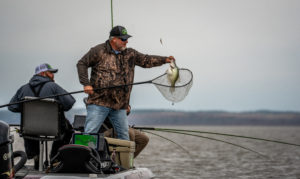Crappie in the pre-spawn: Locating fish
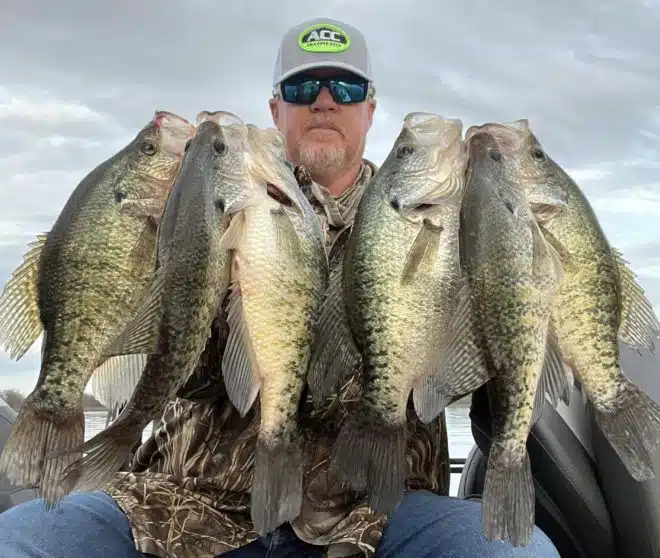
By Greg McCain
One of the most anticipated periods of crappie fishing, the pre-spawn features potential for large numbers and also for the biggest individual fish of the year.
While catching crappie this time of year can be unpredictable, particularly for finicky females awaiting the spawn, the first trick is locating fish. We asked the ACC Crappie Stix pro staff about their approach to fishing in the weeks and months ahead of the spawn, and members responded with a wealth of information about the pre-spawn, that time in late winter and early spring when the fish feed heavily and position before moving to beds.
In a two-part series, we focus on finding the fish today. Part 2 will be posted on the ACC blog soon and provides details about presentations and techniques, along with equipment needed, to catch the fish at this time of year.
In Louisiana and also in east Texas, Keith Acker fishes a variety of lakes that share some common characteristics in the pre-spawn window. In his comments, he also includes a couple of unique qualities of female crappie as they get ready for the spawn.
Keith (friend him on Facebook for his timely reports and other fishing info) typically starts on flats in 10- to 25-feet of water, an idea echoed by several members of the pro staff. However, a point that Keith stresses is that regardless of water depth, crappie will be found at just about any level of the water column.
“I may fish as shallow as three or four feet deep during the pre-spawn regardless of the water temp,” he said. “Then they may spawn on taller trees where the sunlight hits the top in 25 feet of water.”
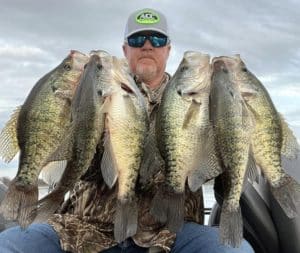
He added that the females will eventually lay their eggs on limbs high in the submberged timber and frequently don’t stray far from where they hold in the pre-spawn. The implication is that not all crappie flock to the bank to procreate.
While conventional wisdom (probably more tradition than wisdom) suggests that crappie spawn in three- to six-feet of water, anglers in various regions of the country disprove that theory yearly. So in the pre-spawn, anglers should follow the fish, and the majority of females will likely be found in water deeper than anticipated.
While the fish may over water 25 feet deep, Keith has a unique theory about why the females suspend at a certain level in the pre-spawn.
“I can’t prove it, but I’ve been told that those females will set at the same depth in the water column as where they are going to spawn,” he said. “In other words, if the males are making beds in three feet of water, that’s where the females will be holding in the water column somewhere adjacent to the spawning area. I will catch open-water females in as little as two- to three-feet of water.
“I’m not a biologist, but I have verified that idea to an extent using LiveScope over the last few years.”
Specifically, Keith said he starts on the deeper flats “off of the secondary creeks where the fish will be moving up to spawn. The big females will usually be in the upper part of the water column (eight feet or less) roaming or stuck to the side of timber.”
A final consideration offered by Keith involves timing. As he stated, he will typically find the females suspended in deeper water most of the time. At the time of the spawn – perhaps the better word is moment – the fish will migrate to beds “right at dark” only for a short period of time. That fleeting period is best for catching bigger females shallow.
Texas angler Chris Sarge Gill makes a similar point about the brevity of the females’ role in the spawning process in his comments below.
Regardless of where they are found, targeting pre-spawn fish offers some of the best action of the year and the greatest potential for trophy crappie.
“The pre-spawn is definitely the best chance that a fisherman will have to catch a fish of a lifetime,” Keith said.
Following are other suggestions from the ACC pro staff scattered across various regions of the country. Many of the ideas hold true from region to region.
Jody Stephens, Georgia, (Follow Crappie Daze Guide Service on Facebook for guide trip information.)
“Pre-spawn crappie fishing in Georgia is all about stages! It could be mid- to late-February. Start looking in mouths of major coves. If not there, look in the middle of the lake. You never know year to year!
“Find ‘em first and then follow ‘em as they migrate to shallow areas in the backs of creeks to spawn come mid- to late-March. I may start pulling 12- to 14-feet deep in February and wind up pulling in two- to three-feet deep in three- to six-feet of water!”
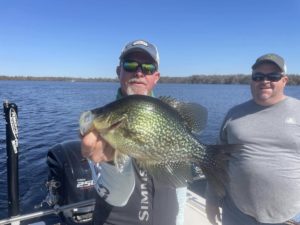
Charlie Burrow, Louisiana and east Texas (See GO FISH with Charlie Burrow on YouTube.)
“East Texas pre-spawn fishing can be the best or worst of times. I try to keep it simple and not overthink it. When water temps hit 50 degrees, I leave my normal deep-water submerged timber and target the mouths of pockets leading into the spawning areas. Although a few fat fish will relate to timber, the majority will be roaming or as I call them free range chickens.”
Jonathan Phillips, Alabama (Follow Team Phillips Guide Service on Facebook for guided trip information.)
“Pre-spawn fishing, I usually target flats near a channel or at least near to deeper water. Due to the fluctuation in water temps, the larger fish usually like to position close to a channel so they can move in and out accordingly. Most fish I target are free ranging and not particularly relating to structure most days.”

Daniel Ellis, Tennessee (Friend him on Facebook for fishing reports and other info.)
“On Kentucky Lake, the sky is the limit. It depends on exactly what part of the pre-spawn you are in. A lot of them right now are in that 15- to 30- feet where we solely single-pole fish for them over structure.”
Jeff Jowers, Alabama (Follow Southern Scale’s Guide Service on Facebook for guided trip information.)
“For me personally, it’s my favorite time! I target those big beautiful females, fishing flats adjacent to creek channels, at times in the channels depending on weather, fronts, etc.
“I typically break the creek up in three different sections, starting at the mouths of the creeks and working my way to the middle of the creek. As it gets closer for them to do their thing and the water temp gets warmer, I will then focus on the backs of the creeks where at this time you can find them relating to structure as well as in open water.”
Chris Sarge Gill, Texas (See Asleep at the Reel on YouTube.)
“Here in east Texas, the crappie are starting to move in. Specifically, I target the spawning females. Most people hit the banks in search of that shallow-water crappie on a bed, but those are mostly males. A quick fact is the females take roughly two hours to lay eggs, which means the rest of the time they are in the 10- to 12-feet-of-water staging area stacked on trees. Black crappie spawn first. Then the whites come in, making it a several-month process, at least here.
“While these females are in that 10- to 12-feet of water, their job is simply to hang out and eat until mother nature directs them to go to the bank. This is probably one of my favorite times to fish and a great time to catch those two-plus-pound crappie.”
Goose Gutzman, Minnesota (friend Goose on Facebook for info about guided trips and also for a wealth of fishing info.)
“In central Minnesota, the crappies start moving into the shallows even before ice out, and some never leave if the weeds stay green. During this time right after ice out, they start getting their feedbags on, and most of the basin crappies are either in the weeds or mud bays or relatively close.
“Eventually they will move in to their typical spawning grounds, and the males are getting the beds ready and soon the females will move in. if it’s not windy, you will visually see them in the bullrushes or in the weeds.”
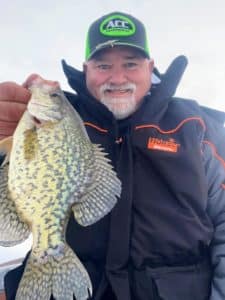
Don McClish, Oklahoma (follow PointBreak Crappie Guide Service on Facebook for guided trip information.)
“Here on the big “E” (Lake Eufaula, OK), there’s numerous ways and a variety of areas that these crappie will spawn on from rip-rap along the highways to small pockets off of the main lake to big bays to protected main lake shale flats and of course in all of the major feeder creeks.
“I’ll start working the spawn areas when the water temp hits the mid 50s … and in any of the above mentioned spawning areas, regardless of the water depth, I’ll set my rods at the depth of two, four, six, and eight feet because in some of these areas the fish I fish for may be suspended shallow in 30 feet of water in the channel and only travel a hundred foot or so to spawn. (They) then hang out around the breakline until winter and then back to wherever the shad are. Now, if I’m concentrating on the main lake pockets with an average depth of 8 feet … these fish usually hang out near the mouth and as the sun warms these pockets up, they’ll run up shallow.”
Justin Smart, Louisiana (Friend Justin on Facebook for reports and other fishing information.)
“I really like to fish the flats this time of year in 12- to 16-feet of water and find those big fish hanging out deeper while many of the fish are on the banks spawning.”
Tim Howell, MIssissippi (Follow Long Branch Guide Service LLC on Facebook for guided trip information.)
“I like to target the mouth of creeks and the flats just adjacent to mouths. I’m looking for the big females that are staging up getting ready to run up shallow.”
